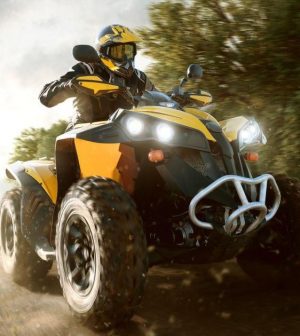- Navigating Your Midlife Crisis: Embracing New Possibilities
- City Raccoons Showing Signs of Domestication
- Mapping the Exposome: Science Broadens Focus to Environmental Disease Triggers
- One Week Less on Social Media Linked to Better Mental Health
- Your Brain Changes in Stages as You Age, Study Finds
- Some Suicide Victims Show No Typical Warning Signs, Study Finds
- ByHeart Formula Faces Lawsuits After Babies Sickened With Botulism
- Switch to Vegan Diet Could Cut Your Greenhouse Gas Emissions in Half
- Regular Bedtime Does Wonders for Blood Pressure
- Dining Alone Could Mean Worse Nutrition for Seniors
Helmets Can Saves Lives in ATV, Dirt Bike Crashes

New research provides further proof that helmets are essential for young users of all-terrain vehicles (ATVs) and dirt bikes.
Wearing a helmet significantly reduces their risk of moderate or severe head injuries in crashes, and also lowers their risk of death, the study found.
“For neurosurgeons treating pediatric trauma patients, these findings are not at all surprising,” said study co-author Dr. Aaron Yengo-Kahn, of the Vanderbilt Sports Concussion Center in Nashville, Tenn. “What is startling is that the rate of helmet use for patients presenting to the emergency department has not really changed and the consequences are obvious.”
The study included 680 patients between the ages of 1 and 17 who were involved in recreational ATV or dirt bike crashes and treated at Vanderbilt University Medical Center between 2010 and 2019.
Of those, only 34% were wearing helmets when they crashed. Drivers were more likely to be wearing a helmet than passengers (44% vs. 10%), and boys were more likely to do so than girls (39% vs. 22%).
When they crashed, more dirt bikers (70%) were wearing helmets than ATV riders (22%).
Compared to those who wore helmets, patients who weren’t wearing helmets were more likely to be intubated before arrival at the emergency room (5% vs. 1%) and to be transferred to the intensive care unit (20% vs. 10%).
Riders without helmets were more likely to be diagnosed with moderate or severe traumatic brain injury (8% vs. 2%), and to have a skull fracture (18% vs. 4%) or intracranial hemorrhage (16% vs. 4%).
Twelve riders without helmets (13%) required a neurosurgical procedure, and one helmeted rider (0.4%) received an implant to monitor pressure in his skull.
Three of the riders without helmets died, two of brain or spinal trauma (neurotrauma). Two helmeted riders died, one of neurotrauma.
Riders had a similar length of time in the hospital — a median of two days, meaning half had a longer stay, half shorter. More than 98% of riders achieved a good clinical outcome as of the last follow-up.
The findings were published Oct. 12 in the Journal of Neurosurgery: Pediatrics.
“Serially updating the literature on public health topics is critical in order to reinvigorate efforts to improve injury prevention,” Yengo-Kahn said in a journal news release. “We hope the results of this study can do just that.”
More information
The American Academy of Pediatrics has more on ATVs.
SOURCE: Journal of Neurosurgery: Pediatrics, news release, Oct. 12, 2021
Source: HealthDay
Copyright © 2025 HealthDay. All rights reserved.










